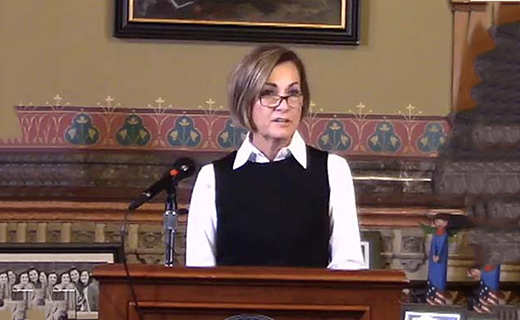Gov. Kim Reynolds’ administration is using $10 million in federal pandemic relief funds to pay the salaries of state police officers, who have played only a small role in Iowa’s virus response.
The expense is listed in a state report as going toward “State Government COVID staffing” at the Iowa Department of Public Safety. The report claims the money will support payroll expenses for employees “whose services were diverted to a substantially different use as a result of COVID-19.”
Department spokeswoman Debra McClung said the money is predominantly supporting salary costs for its roughly 550 sworn officers, who include road troopers and criminal investigators. They have largely carried on their routine duties during the pandemic, including enforcing traffic laws and helping local police investigate crimes.
McClung did not provide examples of how any duties had changed. Instead, she said the spending appears to be allowable under revised guidance from the Treasury Department, which said in October that payroll expenses for public safety employees are presumed to qualify as pandemic-related.
The same guidance document, however, says qualifying expenses are intended for employees who “have been diverted to substantially different functions” as a result of the emergency, such as a police officer who has been reassigned to enforce a stay-at-home order.
Reynolds has faced criticism for using Iowa’s $1.25 billion coronavirus relief fund, approved by Congress to help governments, businesses and workers respond to the pandemic, to pay for non-related expenses while the virus rages. At the same time, the state has its own budget surplus and reserves exceeding $700 million.
On Monday (12/14), the Governor announced that she was abandoning plans to use $21 million from the relief fund to pay for an executive branch human resources and accounting software system, which had been planned long before the pandemic.
That money will be returned to the fund for a different use by Dec. 31 or will be reallocated to the federal government. The move came after State Auditor Rob Sand and Treasury’s inspector general agreed several weeks ago that the project did not qualify.
The governor’s spokesman said the state is moving forward with plans to use $16.9 million from the fund for a different long-term IT project whose origin also predated the virus and is not directly related to it. So far, only $39,000 has been spent on the project that aims improve data management across state agencies, which the state report says will help “during another pandemic.”
Bleeding Heartland, a blog authored by the journalist Laura Belin, reported on documents last week showing the Republican governor used $448,000 from the fund to cover a shortfall in her office budget. That spending was routed through the Homeland Security and Emergency Management Department and is classified as supporting “state government COVID staffing.”
Sand, a Democrat, has also questioned whether the $448,000 was the best use of virus aid, and his office is examining other aspects of the spending.
“At the end of the day, this is supposed to be about alleviating a crisis for Iowans and a lot of these uses aren’t the best way to do that even if they might technically qualify,” Sand said Tuesday.
Reynolds’ office defended the overall use of relief funds Monday, saying hundreds of millions of dollars have been used to support businesses, farmers, communities and health care providers. Nearly half of the money, $490 million, has gone to the state’s unemployment insurance fund, which will help businesses that pay into it avoid higher taxes.
For the public safety department, the $10 million influx represents nearly 10% of its annual state budget. The department includes the Iowa State Patrol, the Division of Criminal Investigation, the Division of Narcotics Enforcement and the State Fire Marshal, among other units.
The department’s priorities have been reshaped somewhat by the virus’ impact on society.
The patrol has sought to crack down on what it’s called an alarming increase in excessive speeding that has occurred during the pandemic even though people have traveled less. Investigators have also seen an increase in child pornography cases.




